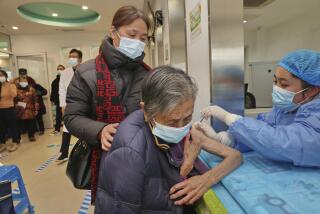Mystery Illness Claims Life of Doctor Who First Warned of World Outbreak
- Share via
The Italian physician who first recognized that the world was facing an outbreak of a mysterious pneumonia-like illness died Saturday in Hanoi, a victim of the inadequate medical procedures in place before the disease’s severity was recognized.
The disease -- called severe acute respiratory syndrome, or SARS -- meanwhile continued its spread around the world, with 58 new cases in Hong Kong alone, some of them among residents of a single floor in an apartment building.
Public health authorities in Singapore expanded an existing quarantine to more than 1,500 people. Canada closed a second hospital where health-care workers had been exposed to the virus.
The World Health Organization urged the most heavily afflicted countries to begin screening departing airline passengers for symptoms of the illness. And the U.S. Centers for Disease Control and Prevention expanded its warning against unnecessary travel to Singapore and all of China, in addition to Hong Kong and Vietnam.
The World Health Organization said that, as of early Saturday, there were 1,553 suspected cases of the disease in 13 countries and 54 deaths.
China remained the most heavily affected with 806 cases, followed by Hong Kong with 470, Singapore with 89 and Vietnam with 58.
The United States had 62 suspected cases, but there have been no deaths yet. Canada had 37 probable cases and 36 more suspected cases, with three deaths to date.
“Our biggest unknown is what is going on in China,” which has been very closemouthed about epidemic-related events, said Dr. Julie L. Gerberding, director of the CDC. “We’re desperate to learn more about the scope and magnitude of the problem there. That will be the biggest predictor for where this [epidemic] will go over the next few weeks.”
On Wednesday, China revealed that it had had more than 800 cases of SARS and 34 deaths, well beyond the 300 cases and five deaths it originally reported. Chinese officials said Friday that they would begin making daily case counts and fatalities available to health agencies electronically but that it would take several days to bring the system online.
The most recent fatality from the disease was Dr. Carlo Urbani, 46, an expert on communicable diseases who had worked in WHO health programs in Cambodia, Laos and Vietnam. Urbani diagnosed the illness in an American businessman who had been admitted to a hospital in Hanoi. The businessman subsequently died.
Because Vietnamese authorities did not realize initially that they were dealing with such an infectious illness, few precautions against its spread were in place and 56% of the health workers who came in contact with the businessman developed SARS themselves -- accounting for nearly half the cases in that country.
Because of Urbani’s early efforts, WHO said Saturday, global surveillance was heightened and many new cases were identified and isolated before they could infect other hospital staffers.
Urbani was married and the father of three children.
“Carlo Urbani’s death saddens us all deeply at WHO,” said Dr. Gro Harlem Brundtland, the WHO director-general. “His life reminds us again of our true work in public health.”
Outside mainland China, the effects of the epidemic have been felt most severely in Hong Kong, where thousands of residents are wearing face masks to prevent infections and many others are simply not venturing onto the streets. The Hongkong & Shanghai Banking Corp. shut part of a floor at its main office Saturday after a worker became ill, and the Bank of China closed a branch for thorough cleaning after a staff member there developed symptoms.
Antiwar demonstrations have been called off, the Rolling Stones have canceled appearances in China, and some crews on Cathay Pacific Airways have been wearing masks during flights. The airline, Hong Kong’s largest, said some flights might be cut.
The biggest concern was the new cases among residents of an apartment building. Although authorities have released few details about this new outbreak, experts fear that it could mean a broader incursion of the disease into the general community. So far, virtually all of the cases have been attributed to prolonged, direct contact with patients, with most cases occurring among health workers and family members of patients.
But seven cases were previously known to have occurred among people who stayed on the floor of a Hong Kong hotel where an undiagnosed patient was staying.
Singapore Airlines also said Friday that an attendant on the flight that carried a Singapore physician to Germany, where he was quarantined with SARS, has now been diagnosed with the disease.
Hong Kong’s health secretary, Dr. Yeoh Eng-kiong, said that the SARS outbreak is a tougher challenge than the 1997 avian influenza outbreak that killed six people in Hong Kong.
“The bird flu was simpler,” he said. “All you had to do was kill the chickens. Now you are dealing with humans.”
In Canada, Ontario officials late Friday ordered the closing of York Central Hospital in Richmond Hill after four cases of the disease were discovered at the facility. Toronto is the site of the largest outbreak of SARS outside Asia, and officials had previously closed Scarborough Grace Hospital in Toronto.
Three other Toronto-area hospitals are now accepting only critically ill patients in an effort to limit the spread of the disease.
“It is very likely that we will continue to see an increase in the number of cases,” said Hanif Kassam of the York region health department. “Whatever steps are taken, there will be a time period before we see any sort of reduction.”
SARS is characterized by fatigue, high temperatures, coughing and difficulties in breathing. Physicians from 11 countries who conferred Friday in an unusual electronic linkup said 90% of victims recover from the illness with normal supportive care.
Those most at risk of developing more serious symptoms are those with other illnesses, such as infectious diseases and heart ailments. The death rate so far is about 3.5%.
Although researchers initially suspected that the disease was caused by a paramyxovirus, most now are leaning toward the conclusion that it is triggered by a previously unknown coronavirus, a member of the family that causes colds and other respiratory illnesses in humans and animals.
The coronavirus was initially identified by CDC researchers, but labs in seven other countries have now found evidence of its role, said the CDC’s Dr. James Hughes.
“The preponderance of evidence in support of coronaviruses as the cause is mounting,” Hughes said.
The CDC has developed antibody and genetic tests to identify the virus and hopes to begin distributing them to local public health authorities within a week, Hughes said. The tests will help identify which suspected cases are caused by the disease.
There are no known drugs that kill coronaviruses.
More to Read
Sign up for Essential California
The most important California stories and recommendations in your inbox every morning.
You may occasionally receive promotional content from the Los Angeles Times.










